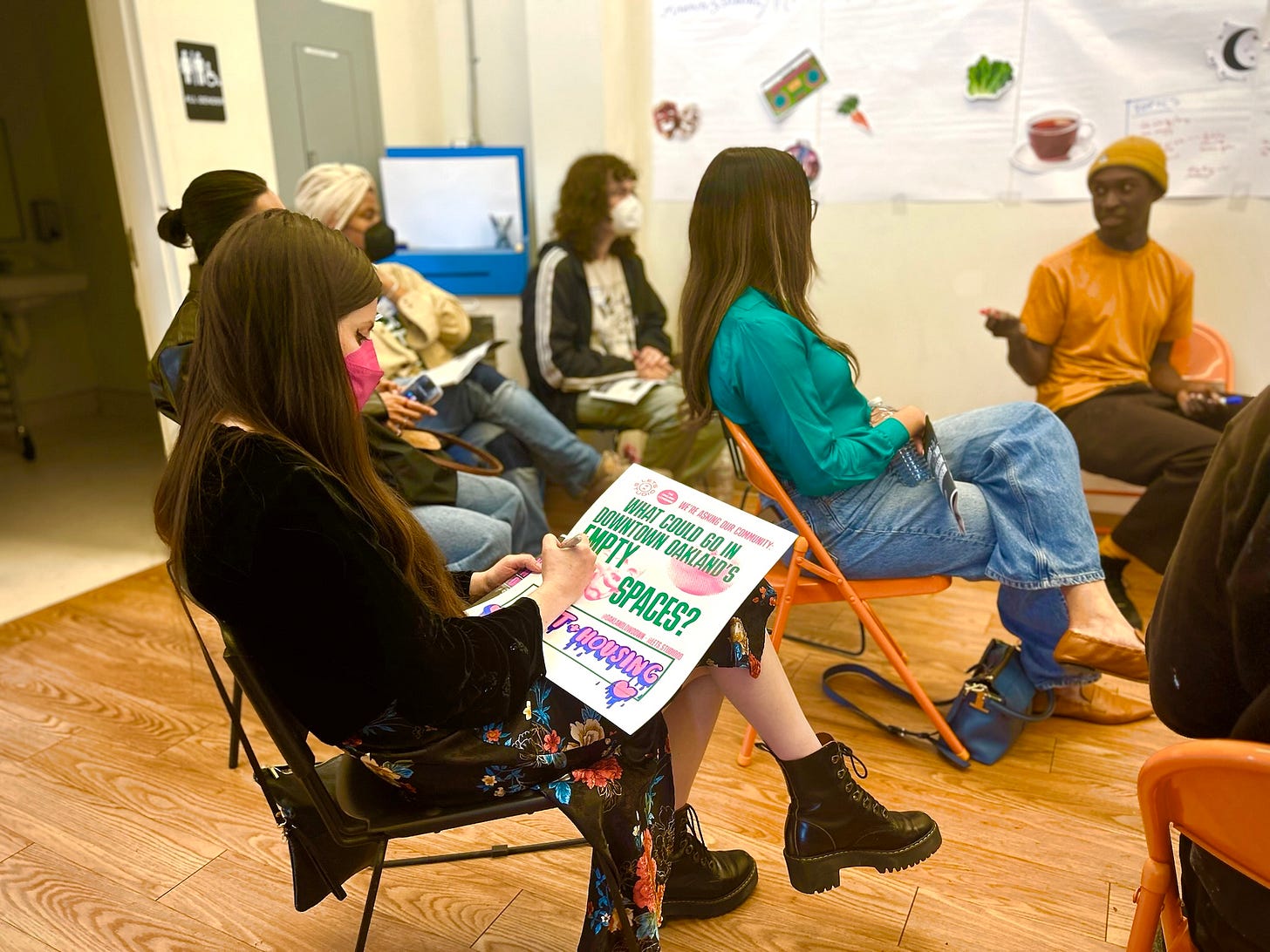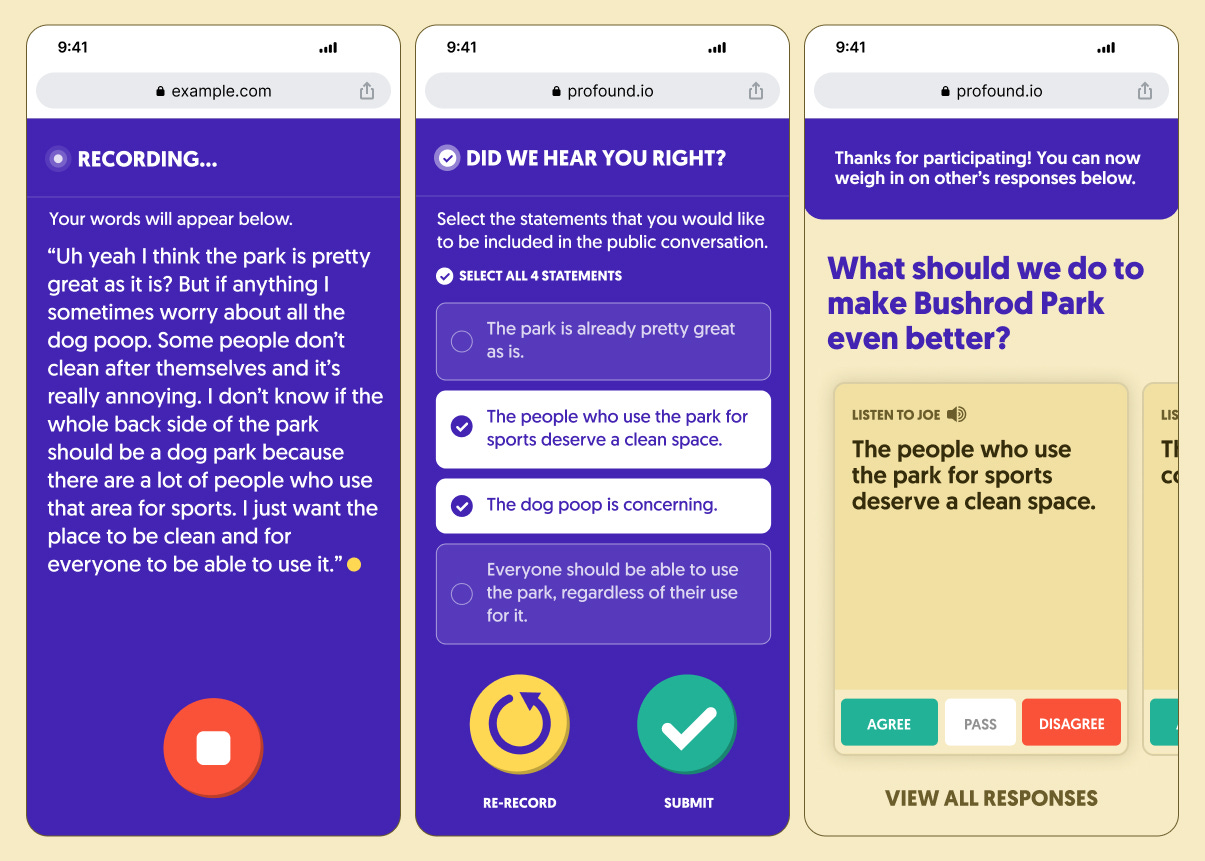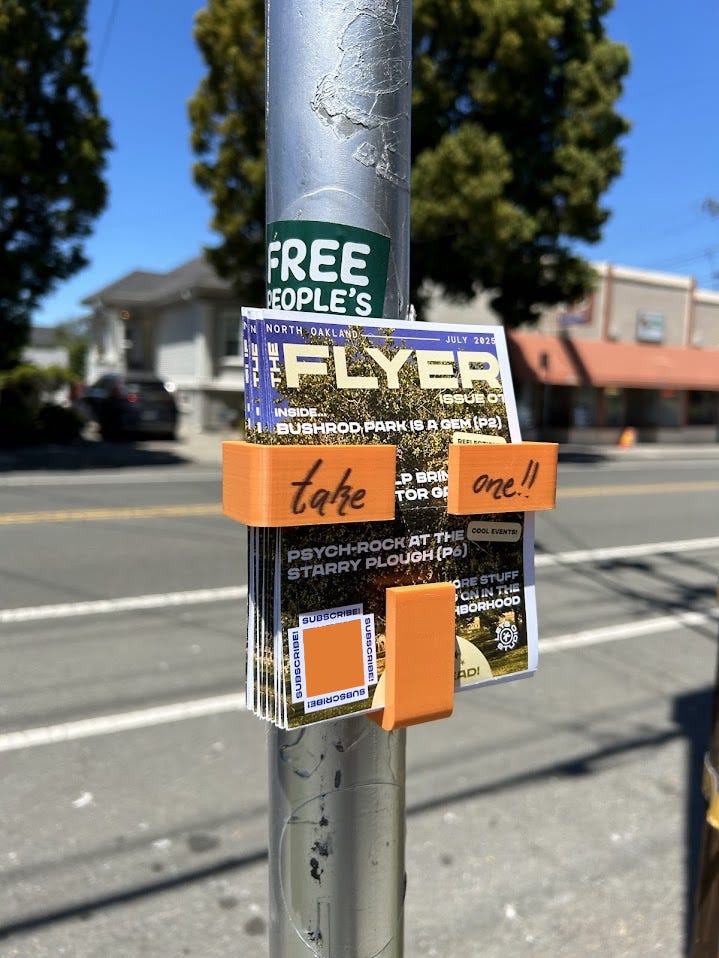An Overdue Update
What I've been up to for the past year, and the two projects I'm working on now (public conversations, hyperlocal media).
Quick request: I’m looking for a web developer to jam with on tools for constructive, large-scale public conversations! And if you’re excited by that but aren’t a developer, hit me up anyway.
===
Phew! It’s been awhile.
As you can probably tell, I am not the best at sending regular updates on my work. I tend to get wrapped up in whatever’s immediately in front of me and forget to write things up, despite the fact that it is genuinely very useful for feedback, articulating and grounding my thoughts, etc. I’m still not making any promises as to when the next update will be, but this particular moment (on a plane with no wifi, post-masters degree) feels right to write up what I’ve been up to for the last few years – and how I’m orienting to the newest chapter of my life.
A lot of the last two years have been spent supporting other community-based initiatives. I started LETS with a gig supporting another organization (Civity) as they tried to help cities in the South Bay have healthier conversations about housing density. But since then most of my attention has been on my new home (Oakland), where I’ve done everything from designing surveys for a restorative economics organizing collective to helping merchants in Old Oakland organize a street festival. The vast majority of my time was actually spent talking with neighbors in a small part of Downtown Oakland, trying to understand how we could activate the vacant storefronts in the area into something more community-serving. The vast majority of this was on a volunteer basis, figuring out how my various skills in facilitation, design, and communication can be genuinely helpful to causes I care about in my community.

All of this was happening while I was in grad school, which created opportunities to question how public institutions could more directly support community-based knowledge and action. I got lucky and was able to work with the Possibility Lab for the entirety of my time there, where it just so happened that they were spinning up a new research initiative on collaborative governance. While I was there, the Goldman School also launched a new initiative to figure out what the field of “democracy policy” might look like, and I got to design an 100+ engagement with Pol.is to engage public policy professionals on that question. I taught a mini-course on “Power, Participation, and Public Policy”; yapped about participatory democracy with my favorite professor over coffee every few months; wrote papers about how spontaneous spaces and unplanned interventions in cities are crucial for democracy; and made friends from around the world who care about the same questions I do.
So yeah, a lot happening! But most of all, it feels great to have taken the time to fully commit to this work. Grad school was intended to be a space for me to intently learn deeply about democracy in theory in practice, and connect with people who shared my interests. While the depth of questions I was exploring probably could have been a PhD (something I still think about sometimes…), that would have felt too long and I’m ready to get my hands dirty again.
Embedding myself into different projects and community-serving initiatives was a great way to know the place where I live deeply, and to see how collective action is spurred in different ways. But in my heart, I have always wanted LETS to be an incubator for new practices that support democratic life, especially in cities and neighborhoods where we live. The practice of living, learning, and acting together in place deserves tools and spaces that are designed to enhance those things. And if these are indeed the essential practices that support a thriving democracy, they deserve to be treated as infrastructure – accessible, robust, effective, and thoroughly integrated into our lives as citizens (broadly defined). What would make it possible for everyone (or at least significantly more people) to participate fully in the decisions that affect them, rather than just the people with the most time and money? What tools could help people understand each other’s interests and positions, and promote actions that take them towards more just and abundant futures (instead of spiraling into mayhem online)? How can we support each community’s agency to develop their neighborhoods on their own collective terms, and create a common foundation for themselves and future generations?
There are two projects that have emerged in the last few months. I’ll probably be posting about each of these as they progress, so this is more of a teaser and a provocation than anything super substantial. It comes down to two things that have been at the core of my beliefs about what supports a healthy, participatory democracy: tools for neighborly connection and constructive conversations.
The Flyer (Neighborhood Connection)
One of the very first things that I did under the LETS banner was a little experiment in the Mission District to see how people interact with QR codes. I was mostly interested in how to use them to start a local conversation, one that required you to actually be present and was therefore only discoverable through physical presence. To be honest, that particular project wasn’t super well-conceived; the question was way too broad and I didn’t have a very strong plan for what to do after receiving the responses. But even still, a few people showed interest, and I got a bit of a thrill for starting local conversations (a practice that I’ve continued through the Empty Storefronts work and elsewhere).
What I am most interested in now is media that enables conversation between people who live in a specific place. Permanent physical infrastructure is what I’m most interested in, as it naturally engages the people who are committed to a given place and it reinforces the fact that local connection should be an accessible utility. We used to have things like newspaper boxes that distributed local news to local places, but that’s died alongside the rest of local journalism. Since then, I’ve found a couple good examples of place-based media that tries to establish with a more permanent physical presence; for example, Julia Gitis has been prototyping digital bulletin boards in San Francisco. To this day, Community Memory – a project in the 80s that placed computer terminals in record shops, laundromats, and other spaces – is still one of the best examples of urban participatory media that I can think of. More than anything else, I still find the most inspiration in the humble ways neighborhoods already reach their neighbors, like through bulletin boards and flyers on telephone poles.
With all that in mind, The Flyer is my own experiment in neighborhood-based media. It has three components:
A zine, containing personal reflections, local events, polls, and opportunities for civic engagement.
A zine holder that attaches to existing infrastructure, like poles and signposts. Gives it a physical, contextual presence in the neighborhood and makes local media accessible (rather than losing it in the slog of other posts on Instagram or otherwise)
A website that enables deeper, participatory interaction with said content (submissions, comments, etc). Currently dead-simple / bare bones, but there’s much more to come here.
By combining all three of these elements, I’m trying to balance between the inherent locality of physical media and the interactivity and accessibility of web media. The emphasis is more on the medium and craft of the thing – place-based, participatory, DIY. In that way, this same approach could be repeated in many other neighborhoods, main streets, or other places, and everything about it could be tailored to that particular community’s needs and traditions. Of course, I have my own dreams about what this could turn into: using NFC or RFID so people can tap into a hyperlocal online conversation, designing more sculptural, decorative holders that speak to something in the neighborhood, etc etc.
So far, the response from my neighbors has been positive! A lot of the “subscribers” so far have left me a note saying they’re so glad that someone is creating something good for the neighborhood. I included a Pol.is conversation on how we could improve the local park, and those who participated submitted a ton of ideas for what they’d like to see; one person even emailed me separately about a conversation they had with a neighbor about their concerns. Slowly but surely, the neighborhood zine is showing its potential to be a gathering point (and hopefully a catalyst for community development).
More than anything, this has been fun for me. I have always wanted to experiment with printmaking as a creative practice, and now I find myself getting into a meditative groove folding and assembling dozens of zines at my kitchen table. Fabricating the holders has reawakened my high school/early college fascination with 3D printing*, and creating the very basic homegrown website feels much better than writing reports. And by committing myself to documenting my neighborhood, I’m finding a way to channel my natural curiosities about the local pizza joint, homes in the neighborhood, and more into something valuable for my neighbors. It feels like a genuine creative/artistic practice – one that feels novel and uniquely my own.
Profound (Public Conversations)
If I’ve learned anything through my years of researching participatory democracy, it’s that conversation is at the heart for responsive public decision-making. We make sense of complex issues not just through numbers and data, but through stories of people who have actually been affected by the issue at hand. Exchanging arguments is how we find our shared values, and negotiate policies that can successfully address our greatest needs. When people talk about a “healthy public sphere,” this is the stuff they’re talking about. This – not just raw expression or elections, but dialogue and deliberation – is what’s at the heart of a democratic society.
As a technologist at heart, I’ve always been drawn to the tools that help us have better conversations – ones that help us bridge across our differences and find common ground, rather than amplify the loudest voices and most aggressive in the room. Many folks I respect have talked about the importance of “bridging algorithms“ that promote contributions that have the potential to connect people across ideological divides. I remember when I first discovered the magic of Pol.is, a tool that enables large-scale conversations with this bridging approach in mind and produces extremely helpful maps of rich public opinion, areas of consensus and disagreement, etc. But despite the utility of the tool, it has always felt a bit more like a research tool than a civic utility to me. I don’t yet see the people who I respect as civic pillars in my community – public servants, organizers, journalists, and more – using it to enhance public voice and dialogue.
After years of researching and using other people’s tools, I’m finally at a point where I feel confident enough to propose my own alternative: something I’m calling “Profound” for now. Tools like Pol.is are great, but summarizing your thoughts in a tweet-length post misses out on a lot of the nuance and often gives a leg up to people who are used to expressing their opinions online in this way. On the other hand, spoken testimony is a common and natural way to share your full, unfiltered thoughts on a matter. The potential lies in the balance: how to elicit responses vocally, but identify the core, underlying arguments and use them as a basis for exchanging perspectives.

I can see something like this not just being used by government departments (though I would obviously welcome that), but also by the other community-based institutions that hold up the public sphere. I’d want to see more constructive conversations about things that matter to my neighbors, and to see the learnings from that enabling some sort of action (through bottoms-up organizing or through government). As infrastructure, I’d want to see these public conversations happening regularly, and to see people learning not just about the issues but about the people they live with, and developing skills in political articulation in the process.
There are definitely some tricky questions in all of this. Large language models are actually a near-perfect fit for this kind of task (identifying claims within natural language, translating across domains of language and experience, etc), but preserving the original intent, emotion, and other aspects of a person’s political voice is another matter entirely. Figuring out how to make the process of long-form elicitation feel more soulful than just speaking at length into a black box is another thing I’m curious about. To me, these are not dealbreakers, but questions that make me excited to mess around. Getting it started hasn’t taken long, but I can tell that the research, participant experience, engineering, and facilitation challenges involved in this could easily take years.
In any case, I’ve got a simple prototype of this going already and am looking to flesh it out into an MVP that could be tested at scale. If you’re a web developer itching for a new challenge, hit me up:
So with all that, there are a few things I’m trying to do in the next few months:
Find collaborators/co-conspirators. If you resonate with this work at all and want to collaborate, just reach out! Being able to talk, scheme, and make stuff with others is genuinely helpful and fun for tme. If you think any of this might also be helpful for community-based planning, organizing, storytelling, or whatever else, also reach out (hello @ letsstudio [dot] org).
Fund the work. Right now, both of these projects are totally self-funded; consulting work through LETS basically goes straight into a bank account that I only really touch to support this work (including directly funding the various community-driven projects in Oakland). If you feel particularly inspired and are able to, feel free to donate (LETS is recently a fiscally-sponsored project of the Raft Foundation, an organization that supports projects focused on democratic renewal and other community-serving work). Or, if you happen to have deeper pockets/connections and are interested in funding in this work in a more significant way… let’s chat.
If you feel compelled to help in either of the following ways, please do so! But truly, it warms my heart just to have people actively interested in my work. It’s taken me a very long time to give myself permission to work on the things that I care about, and I consider a blessing to do it every day I’m able. Thanks for following along :)






all of this is so awesome and excited to see what's to come!!!
So cool Humphrey!! Love seeing the work you're doing with the Flyer especially. I like keeping my eyes peeled for flyers on windows and telephone poles because there usually is something that catches my attention, but rarely do I find reason to follow through with the CTA... mostly because I've been shying away from digital spaces to have conversations and engage in ideas. But can't wait to see how you develop Profound – I really like the voice/audio element, and think verbal testimony is a nice, humanizing alternative to a chunk of text.